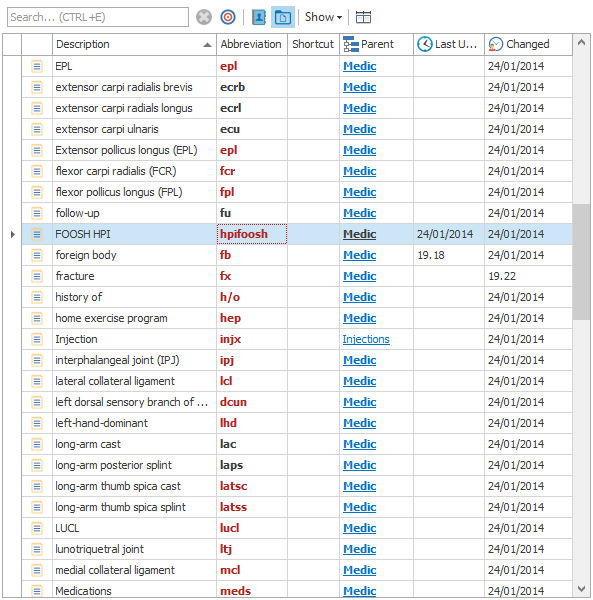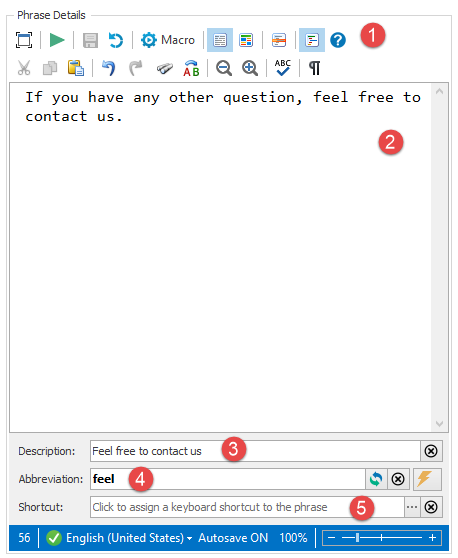Phrases list
An overview of each phrase is shown in the phrases list.

The phrases list
From there you can see:
-Description: the description of the phrase (if no specific description has been assigned to the phrase, a portion of the phrase is displayed). If the phrase contains formatted text, the description is displayed in blue.
-Abbreviation: the abbreviation associated with the phrase to quickly recall it
-Shortcut: an optional keyboard shortcut associated with the phrase
-Parent: the name of the glossary/group containing the phrase
-Last used: the date/time when the phrase was last used
-Changed: the date/time when the phrase was last changed
Operations on the phrases can be performed by selecting one or more phrases and either right-clicking on the phrase, or selecting the Phrases ribbon tab and choosing the required option.
Customizing the displayed columns
1.Right-click on the column header or on the Show button
The menu with the list of columns is displayed
2.Click on any item to hide / display the associated column
Showing / hiding the phrases in all contained groups
PhraseExpander can display in a single view the phrases contained inside all the groups that belong to the selected glossary or group. You can toggle this setting by clicking on the Show phrases in child groups button.![]()
Moving phrases between glossaries and groups
Phrases can be moved between glossaries and groups by a drag and drop from the source glossary to the target glossary, or by selecting the Move to button in the Phrases tab and selecting the desired glossary/group.
NOTE: to add a new phrase, you can double-click on an empty area of the phrases list.
Phrase details
Upon selecting a single phrase, PhraseExpander displays the details of that phrase, allowing you to edit its contents.
Changes to the phrase are saved automatically.

The phrase details pane
1.The phrase details toolbar: you can manage your phrase from here. You can insert ![]() Macros and enable
Macros and enable ![]() Rich text formatting.
Rich text formatting.
2.Phrase contents: this text will substitute the abbreviation when the phrase is executed. PhraseExpander will properly interpret and execute any macros present in the text. By pressing the CTRL+SHIFT+D key combination PhraseExpander will automatically populate the Description and Abbreviation fields for you.
3.Description: this text serves as a reminder of the contents of the phrase in the phrases list and in the Suggestions window. If you leave this empty, PhraseExpander will display a portion of the expanded text contents. You can automatically assign a description by pressing the CTRL+SHIFT+D key combination, or clicking on the Autoassign button ![]() (PhraseExpander assigns a non-empty description only if the phrase starts with a Run macro or a Open Website macro).
(PhraseExpander assigns a non-empty description only if the phrase starts with a Run macro or a Open Website macro).
4.Abbreviation: the sequence of letters that will trigger the phrase. When you type that sequence, in any application, PhraseExpander will prompt a Suggestions window, offering you the option to expand the abbreviation to the full text. You may not need to type the whole abbreviation if you have enabled SmartComplete. You can automatically assign an abbreviation by pressing the CTRL+SHIFT+D key combination, or clicking on the Autoassign button ![]()
5.Shortcut: you can assign a keyboard shortcut to a phrase, to immediately trigger it when the key combination is pressed.